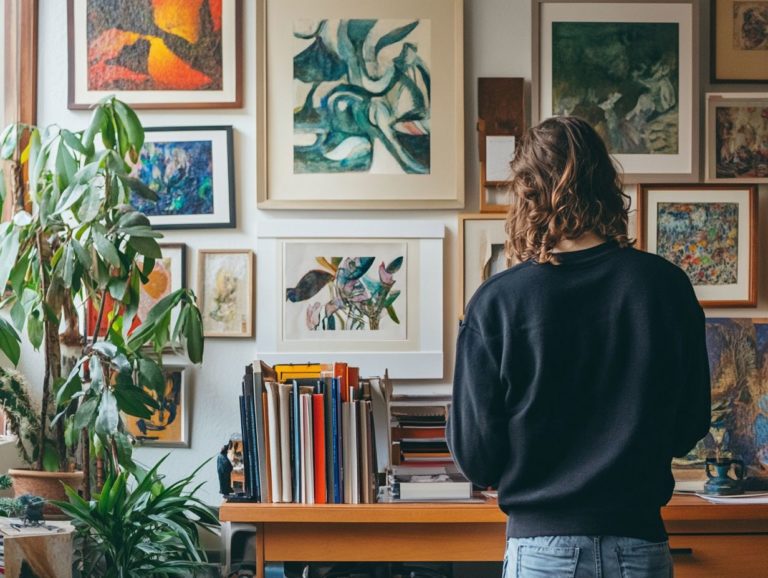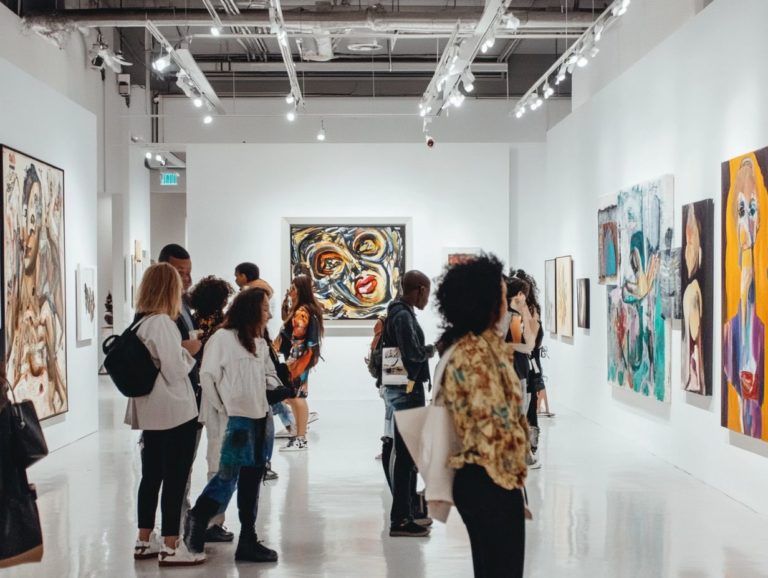5 Art Styles Every Collector Should Explore
Art presents a vibrant tapestry of expression. As a collector, diving into its diverse styles can be exhilarating and rewarding. Get ready to dive into five thrilling art movements that will captivate your imagination!
- Abstract Art
- Impressionism
- Pop Art
- Surrealism
- Contemporary Art
Each of these styles boasts unique characteristics that resonate differently with viewers. It s essential to grasp their nuances.
You ll discover the value of a varied collection, learn how to identify your preferences, and gather tips for curating a stunning array. Immerse yourself in the world of art styles and unveil the joy of collecting.
Contents
- Key Takeaways:
- 1. Abstract Art
- 2. Impressionism
- 3. Pop Art
- 4. Surrealism
- 5. Contemporary Art
- Why Should Collectors Explore Different Art Styles?
- How Can Collectors Determine Which Art Style They Prefer?
- What Are the Benefits of Having a Diverse Art Collection?
- How Can Collectors Educate Themselves on Different Art Styles?
- What Are Some Tips for Building a Diverse Art Collection?
- Frequently Asked Questions
- What are the 5 art styles every collector should explore?
- Why should collectors explore these 5 art styles?
- Can collectors mix and match these art styles in their collection?
- Are these art styles limited to specific mediums?
- Are these art styles only meant for experienced collectors?
- Where can collectors find art pieces within these 5 styles?
Key Takeaways:

Explore diverse art styles to expand your collection and appreciation for art.
Understand the key characteristics of each art style to make informed decisions about your collection, especially by considering 5 must-know artists for collectors in 2024.
A diverse art collection adds depth and variety, making it more interesting and valuable.
1. Abstract Art
Abstract art stands as a significant movement in visual arts. It invites you to explore shapes, colors, and forms that convey emotional experiences without being connected to real-life objects.
This genre evolved from its early 20th-century roots in movements like Abstract Expressionism and Color Field Painting a style focusing on large areas of color. Today, modern interpretations can be found in contemporary art practices.
Here, the emphasis is on the artist’s creative expression and emotional resonance. You can trace its origins back to pioneers such as Wassily Kandinsky, who believed that color could evoke profound feelings, and Jackson Pollock, known for his drip painting technique that transformed chaotic energy into captivating visuals.
As artists ventured into new methods, the movement broadened to encompass styles like minimalism and geometric abstraction, each reflecting a distinct philosophy.
The impact of this art form resonates deeply, encouraging personal interpretations and fostering emotional connections. It transforms ordinary perceptions of art into an immersive experience, allowing you to engage with the artwork on a visceral level.
2. Impressionism
Impressionism emerged in the late 19th century as a revolutionary movement. It sought to capture the fleeting beauty of light and color in everyday scenes, marking a significant departure from traditional artistic conventions.
This movement celebrated spontaneity and the ephemeral moments of life. It encourages you to explore informal compositions and dynamic brushwork.
Prominent figures like Claude Monet and Edgar Degas truly embodied the Impressionist ethos. Monet was renowned for his water lilies and breathtaking depictions of light across landscapes, while Degas was celebrated for his captivating ballet dancers and intimate urban life scenes.
Their focus on observing natural phenomena and the interplay of light transformed not just the creation of art but also how it was perceived. This laid the groundwork for modern artistic expressions that continue to influence practitioners today, highlighting an enduring fascination with color and personal perception.
3. Pop Art
Pop Art emerged in the mid-20th century as a vibrant response to burgeoning consumer culture. It utilized iconic imagery from popular media to blur the boundaries between high art and everyday life.
This movement drew inspiration from advertisements, comic strips, and mass production techniques, reflecting the growing influence of media on society.
Key figures like Andy Warhol and Roy Lichtenstein played pivotal roles in shaping this genre. Warhol’s silkscreen prints of celebrities exemplified the marriage of art and commerce, while Lichtenstein’s bold, comic-style paintings challenged traditional aesthetics.
Together, these artists articulated a commentary on consumerism, highlighting its pervasive nature. They ultimately influenced contemporary art, which continues to grapple with similar themes of mass culture and society.
Ready to start your art collection? Explore these styles today and find your favorites!
4. Surrealism
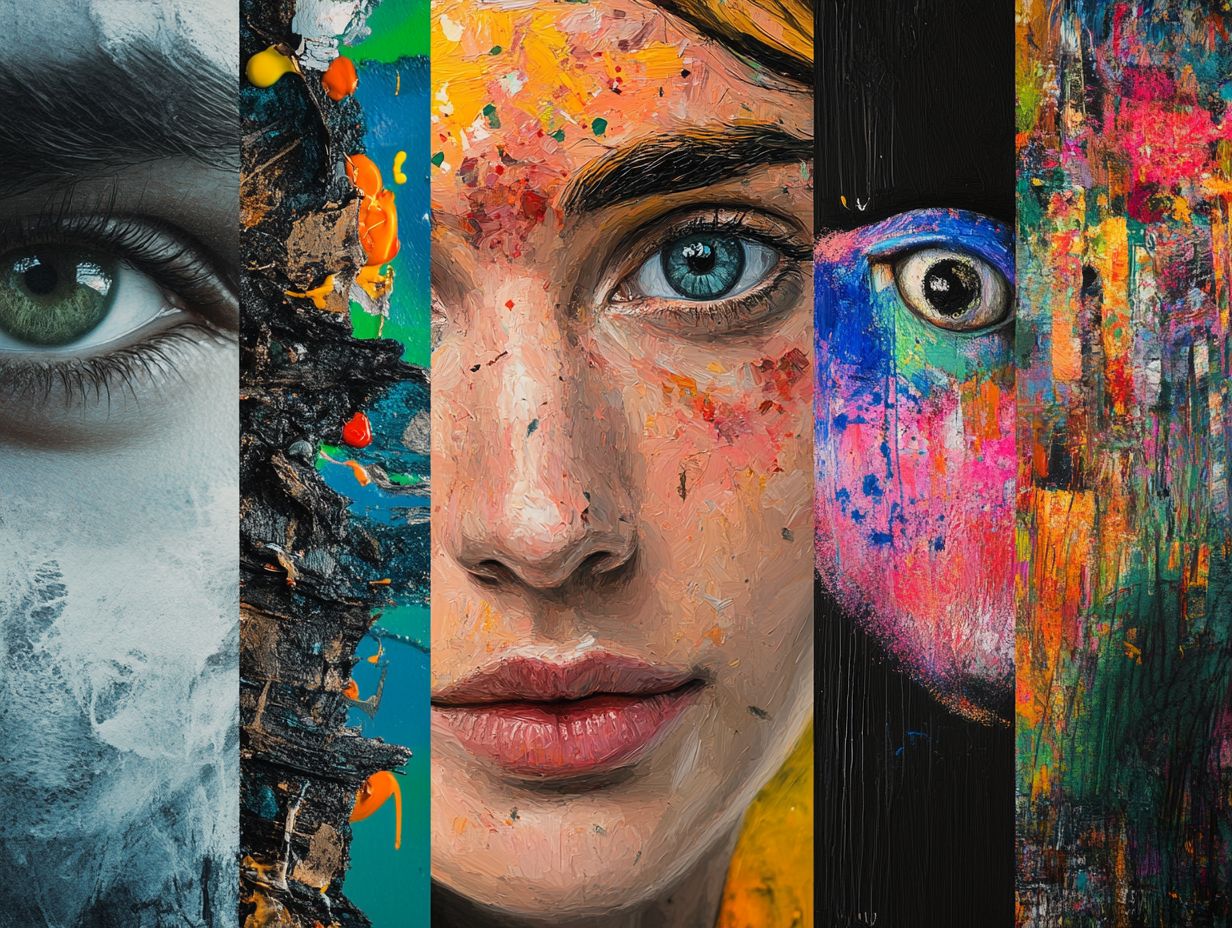
Surrealism, which emerged in the early 20th century, invites you to unlock the creative potential of your unconscious mind. It often employs dream imagery and fantastical elements to challenge the conventions of reality and rational thought.
With roots tracing back to the Dada movement, Surrealism draws from a growing fascination with psychoanalysis, particularly the theories of Freud, who suggested that dreams could unveil deeper truths about the psyche.
Renowned figures like Salvador Dal and Ren Magritte have made significant contributions to this movement. They utilize techniques such as automatic drawing and juxtaposition to create works that provoke thought and elicit emotion.
The absurd and illogical themes provoke strong reactions, leaving an indelible mark on modern artistic practices. Surrealism sparks creativity across various media like literature and film, as artists continue to explore the boundaries of imagination and reality.
5. Contemporary Art
Contemporary art invites you into a rich tapestry of artistic practices and mediums, all echoing the complexities of modern society. It often serves as a poignant platform for social commentary and personal expression.
Today s artists harness the power of digital art to craft immersive experiences that draw you in. Installation art, which transforms your perceptions of space, encourages reflection through interactive environments.
Performance art boldly transcends traditional boundaries, turning the act of creation into visceral experiences that engage you on multiple levels. This diversity not only highlights the innovative spirit of contemporary creators but also gives them the power to confront pressing social issues like climate change, inequality, and identity politics.
By seamlessly adapting to new technologies and platforms, these artists redefine the nature of expression. They invite you to question your realities and actively engage in the dialogue surrounding critical themes.
Why Should Collectors Explore Different Art Styles?
Exploring various art styles allows you to expand your understanding of art movements. This enhances your emotional experience and ultimately leads to a more enriching collection. For those considering this journey, there are compelling reasons to start collecting art today, showcasing a diverse array of artistic expressions and perspectives.
Embarking on this journey through different mediums cultivates a deeper appreciation for techniques and themes. It also presents unique investment opportunities.
For example, diving into Impressionism unveils the transformative nature of light and color. Studying Abstract Expressionism reveals the emotive power of non-representational forms.
Engaging with contemporary styles, such as Street Art, provides fascinating insights into societal commentary and pop culture, resonating with a modern audience. Don t miss the chance to navigate the art market more effectively, identifying trends that may influence future value, making informed investment decisions.
What Are the Key Characteristics of Each Art Style?
Each art style you encounter possesses unique characteristics that define its aesthetic and thematic approach. From the structured forms of Cubism to the fluid expressions of Abstract Expressionism, these styles contribute to an emotional experience that resonates deeply with viewers.
Artistic movements reflect the cultural and historical context of their time. They evoke a range of emotional responses through their distinct use of color, line, and composition.
For instance, Impressionism, with its softer palettes and emphasis on light, invites you to experience a sense of tranquility and fleeting beauty. In contrast, the bold strokes and vibrant hues typical of Fauvism convey raw emotion and energy, often leaving a lasting impression on your psyche.
Every style, while distinct, carries a narrative that resonates through time, engaging you in a dialogue that transforms mere observation into a profound emotional journey.
How Can Collectors Determine Which Art Style They Prefer?
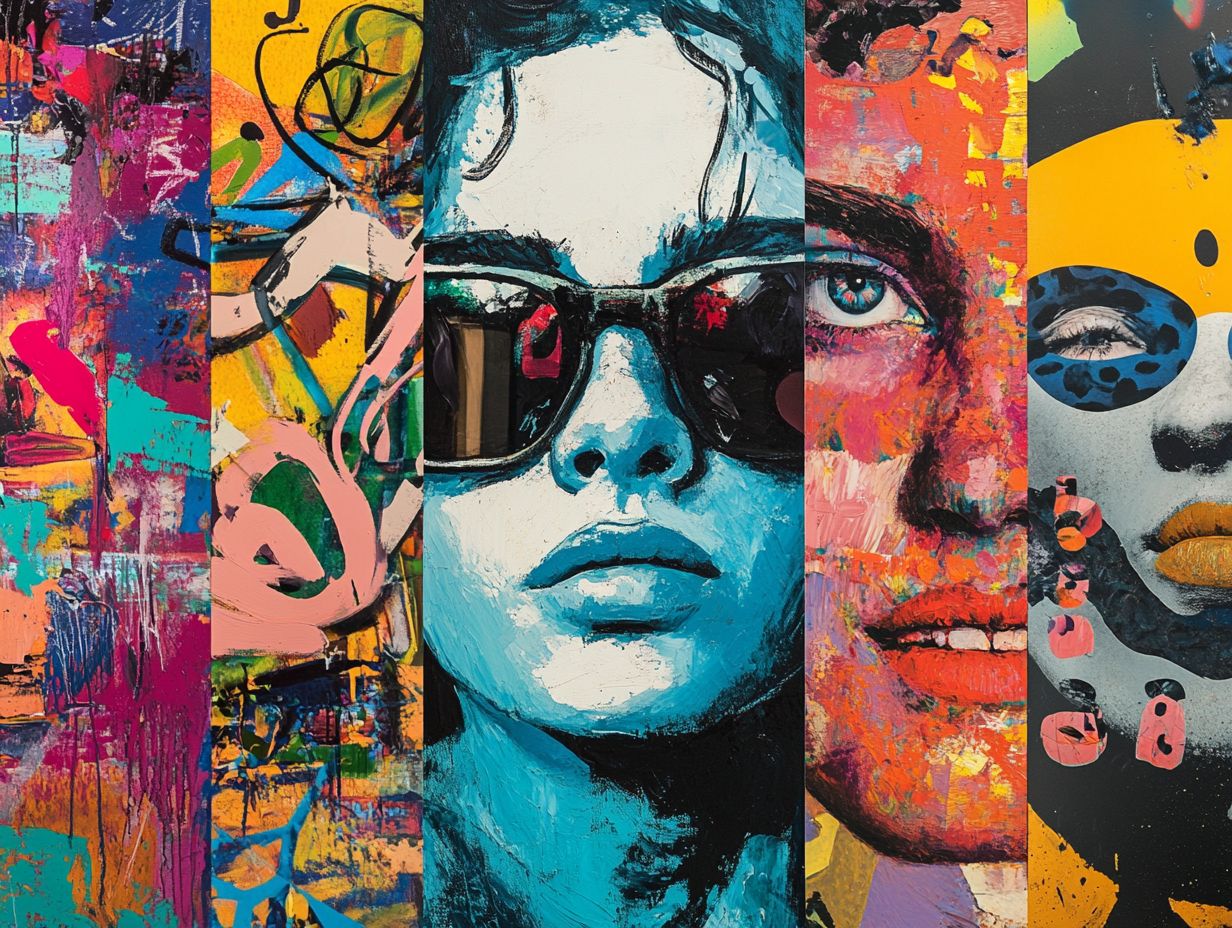
Discovering your preferred art style involves immersing yourself in various artistic practices. Attend exhibitions and reflect on the emotional experiences that different works evoke within you.
Engaging with local galleries lets you explore a rich tapestry of creations and styles. Participating in art communities, whether online or offline, offers avenues for sharing insights and experiences with fellow enthusiasts.
Pay close attention to what resonates with you emotionally. Whether it s the color palette, the materials used, or the themes portrayed, these elements reveal your preferences.
Connect with your feelings during encounters with art. This can guide you toward a collection that truly reflects your unique taste and identity.
What Are the Benefits of Having a Diverse Art Collection?
A diverse art collection enriches your cultural experience and offers potential investment opportunities. It captures a range of aesthetic expressions and historical narratives from various art movements.
This collection reflects your personal tastes while showcasing the richness of global cultures. Incorporating pieces from Impressionism and Modernism immerses you in the evolution of artistic ideas and techniques.
Blending contemporary works with traditional art creates a dialogue between past and present. This approach fosters a deeper appreciation for artistry and may enhance the financial value over time, as unique pieces often appreciate due to their rarity and significance.
An eclectic mix serves as both a cultural treasure and a sound investment for discerning collectors.
How Can Collectors Educate Themselves on Different Art Styles?
You can elevate your understanding of different art styles by tapping into a wealth of resources. Explore books, online courses, and museum visits to enhance your grasp of art history and deepen your appreciation of artistic practices.
Dive into literature focused on art movements. This reveals the intricate nuances and influences that have shaped various styles. Reputable online platforms offer interactive courses for a more engaging relationship with the material.
Local art institutions frequently host workshops and exhibitions, providing opportunities to meet artists and discuss their methods firsthand. Stay updated with contemporary exhibitions; the art world is ever-evolving, and a committed collector must seek out new knowledge.
By immersing yourself in these diverse educational opportunities, you cultivate a richer appreciation for both historical and modern art forms.
What Are Some Tips for Building a Diverse Art Collection?
Building a diverse art collection is an exciting journey that blends personal taste with strategic choices. This unique adventure lets you explore various art styles while considering the potential value of your acquisitions.
To master this balance, regularly engage with current market trends and emerging artists. This ensures your choices reflect your aesthetic preferences and resonate with the evolving art landscape.
Attend art fairs and exhibitions to connect with fellow collectors and industry professionals. Here, you can exchange insights and recommendations to inform your future purchases.
Networking in these settings unveils hidden gems and fosters collaborations. This ultimately enhances the quality and diversity of your collection while keeping it aligned with market shifts.
Frequently Asked Questions
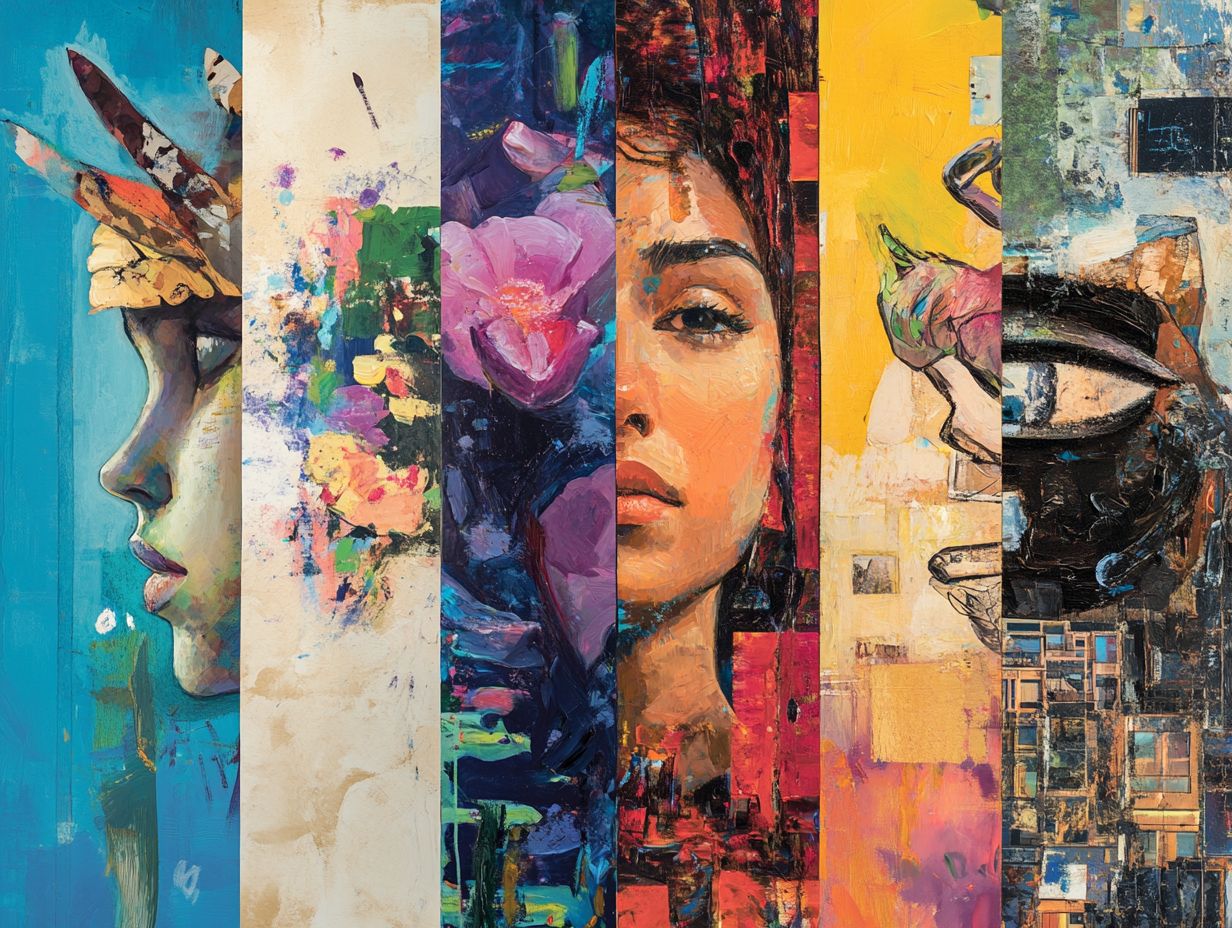
What are the 5 art styles every collector should explore?
The 5 art styles every collector should explore are abstract, impressionism, cubism, pop art, and surrealism. Each style offers unique and distinctive characteristics that can add depth and variety to any art collection, so it’s important to know the 5 things every art collector should know.
Dive into the world of art today and discover what captivates you!
Why should collectors explore these 5 art styles?
Exploring different art styles expands your appreciation for various forms of art. You ll also discover new and emerging artists along the way!
Can collectors mix and match these art styles in their collection?
Absolutely! Mixing art styles adds diversity and excitement to your collection. It creates a unique display that reflects your personal taste.
Are these art styles limited to specific mediums?
No, you can find these art styles in many types of art, including paintings, sculptures, and digital art. The style is all about the artist s unique interpretation.
Are these art styles only meant for experienced collectors?
Not at all! Both experienced and novice collectors can enjoy these styles. It s all about finding what resonates with you.
Where can collectors find art pieces within these 5 styles?
You can find art pieces in art galleries, online marketplaces, and directly from artists. Explore various options to discover unique pieces that truly speak to you!



